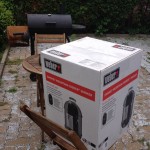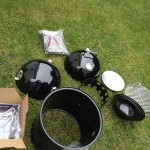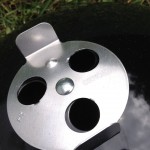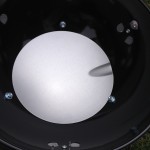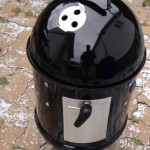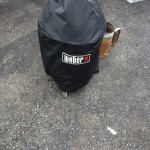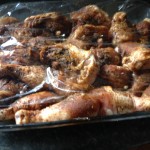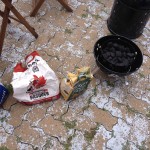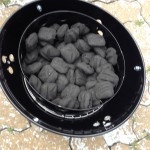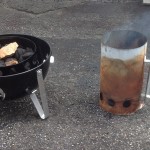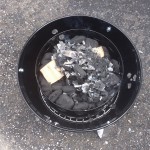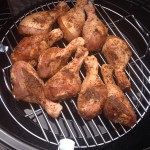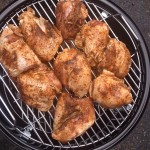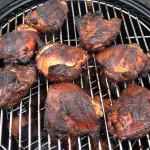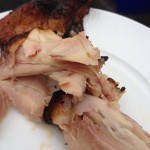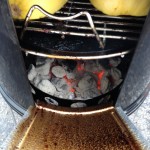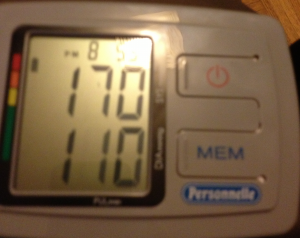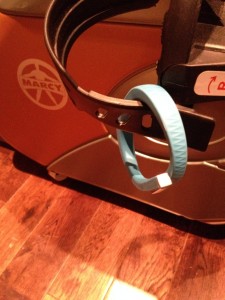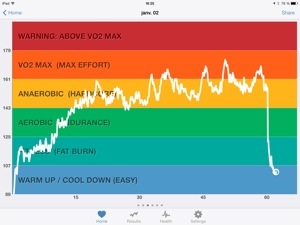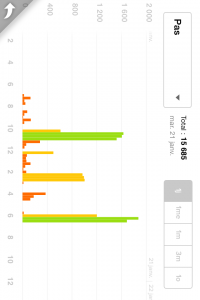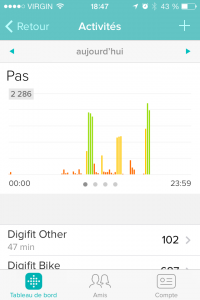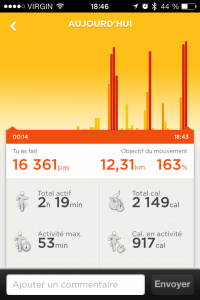Did my inaugural cook in the 14.5″ Weber Smokey Mountain my lifepartner is giving me for my birthday (she knows I don’t like surprises).
Will probably post some written notes of my smoking endeavours, at some point. In the meantime, some pictures documenting the whole thing.
Category Archives: Food
Body and Tech: My Year in Quantified Self
Though I’m a qual, I started quantifying my self a year ago.
Not Even Started Yet
This post is long. You’ve been warned.
This post is about my experience with the Quantified Self (QuantSelf). As such, it may sound quite enthusiastic, as my perspective on my own selfquantification is optimistic. I do have several issues with the Quantified Self notion generally and with the technology associated with selfquantification. Those issues will have to wait until a future blogpost.
While I realize QuantSelf is broader than fitness/wellness/health tracking, my own selfquantification experience focuses on working with my body to improve my health. My future posts on the Quantified Self would probably address the rest more specifically.
You might notice that I frequently link to the DC Rainmaker site, which is a remarkably invaluable source of information and insight about a number of things related to fitness and fitness technology. Honestly, I don’t know how this guy does it. He’s a one-man shop for everything related to sports and fitness gadgets.
Though many QuantSelf devices are already available on the market, very few of them are available in Quebec. On occasion, I think about getting one shipped to someone I know in the US and then manage to pick it up in person, get a friend to bring it to Montreal, or get it reshipped. If there were such a thing as the ideal QuantSelf device, for me, I might do so.
(The title of this post refers to the song Body and Soul, and I perceive something of a broader shift in the mind/body dualism, even leading to post- and transhumanism. But this post is more about my own self.)
Quaint Quant
I can be quite skeptical of quantitative data. Not that quants aren’t adept at telling us very convincing things. But numbers tend to hide many issues, when used improperly. People who are well-versed in quantitative analysis can do fascinating things, leading to genuine insight. But many other people use numbers as a way to “prove” diverse things, sometimes remaining oblivious to methodological and epistemological issues with quantification.
Still, I have been accumulating fairly large amounts of quantitative data about my self. Especially about somatic dimensions of my self.
Started with this a while ago, but it’s really in January 2013 that my Quantified Self ways took prominence in my life.
Start Counting
It all started with the Wahoo Fitness fisica key and soft heartrate strap. Bought those years ago (April 2011), after thinking about it for months (December 2010).
Had tried different exercise/workout/fitness regimens over the years, but kept getting worried about possible negative effects. For instance, some of the exercises I’d try in a gym would quickly send my heart racing to the top of my healthy range. Though, in the past, I had been in a more decent shape than people might have surmised, I was in bad enough shape at that point that it was better for me to exercise caution while exercising.
At least, that’s the summary of what happened which might make sense to a number of people. Though I was severely overweight for most of my life, I had long periods of time during which I was able to run up long flights of stairs without getting out of breath. This has changed in the past several years, along with other health issues. The other health issues are much more draining and they may not be related to weight, but weight is the part on which people tend to focus, because it’s so visible. For instance, doctors who meet me for a few minutes, only once, will spend more time talking about weight than a legitimate health concern I have. It’s easy for me to lose weight, but I wanted to do it in the best possible way. Cavalier attitudes are discouraging.
Habits, Old and New
Something I like about my (in this case not-so-sorry) self is that I can effortlessly train myself into new habits. I’m exactly the opposite of someone who’d get hooked on almost anything. I never smoked or took drugs, so I’ve never had to kick one of those trickiest of habits. But I often stop drinking coffee or alcohol with no issue whatsoever. Case in point: I’m fairly well-known as a coffee geek yet I drank less than two full cups of coffee during the last two months.
Getting new habits is as easy for me as kicking new ones. Not that it’s perfect, of course. I occasionally forget to bring down the lid on the toilet seat. But if I put my mind to something, I can usually undertake it. Willpower, intrinsic motivation, and selfdiscipline are among my strengths.
My health is a significant part of this. What I started a year ago is an exercise and fitness habit that I’ve been able to maintain and might keep up for a while, if I decide to do so.
Part of it is a Pilates-infused yoga habit that I brought to my life last January and which became a daily routine in February or March. As is the case with other things in my life, I was able to add this routine to my life after getting encouragement from experts. In this case, yoga and Pilates instructors. Though it may be less impressive than other things I’ve done, this routine has clearly had a tremendous impact on my life.
Spoiler alert: I also took on a workout schedule with an exercise bike. Biked 2015 miles between January 16, 2013 and January 15, 2014.
But I’m getting ahead of myself.
So Close, Yet So Far
Flashback to March, 2011. Long before I really got into QuantSelf.
At the time, I had the motivation to get back into shape, but I had to find a way to do it safely. The fact that I didn’t have access to a family physician played a part in that.
So I got the Wahoo key, a dongle which allows an iOS device to connect to ANT+ equipment, such as heartrate straps (including the one I bought at the same time as the key). Which means that I was able to track my heartrate during exercise using my iPod touch and iPad (I later got an iPhone).
Used that setup on occasion. Including at the gym. Worked fairly well as a way to keep track of my workouts, but I had some difficulty fitting gym workouts in my schedule. Not only does it take a lot of time to go to a gym (even one connected to my office by a tunnel), but my other health issues made it very difficult to do any kind of exercise for several hours after any meal. In fact, those other health issues made most exercise very unpleasant. I understand the notion of pushing your limits, getting out of your comfort zone. I’m fine with some types of discomfort and I don’t feel the need to prove to anyone that I can push my limits. But the kind of discomfort I’m talking about was more discouraging than anything else. For one thing, I wasn’t feeling anything pleasant at any point during or after exercising.
So, although I had some equipment to keep track of my workouts, I wasn’t working out on that regular a basis.
I know, typical, right? But that’s before I really started in QuantSelf.
Baby Steps
In the meantime (November, 2011), I got a Jawbone UP wristband. First generation.
That device was my first real foray into “Quantified Self”, as it’s normally understood. It allowed me to track my steps and my sleep. Something about this felt good. Turns out that, under normal circumstances, my stepcount can be fairly decent, which is in itself encouraging. And connecting to this type of data had the effect of helping me notice some correlations between my activity and my energy levels. There have been times when I’ve felt like I hadn’t walked much and then noticed that I had been fairly active. And vice-versa. I wasn’t getting into such data that intensely, but I had started accumulating some data on my steps.
Gotta start somewhere.
Sleepwalking
My sleep was more interesting, as I was noticing some difficult nights. An encouraging thing, to me, is that it usually doesn’t take me much time to get to sleep (about 10 minutes, according to the UP). Neat stuff, but not earth-shattering.
Obviously, the UP stopped working. Got refunded, and all, but it was still “a bummer”. My experience with the first generation UP had given me a taste of QuantSelf, but the whole thing was inconclusive.
Feeling Pressure
Fastforward to late December, 2012 and early January, 2013. The holiday break was a very difficult time for me, physically. I was getting all sorts of issues, compounding one another. One of them was a series of intense headaches. I had been getting those on occasion since Summer, 2011. By late 2012, my headaches were becoming more frequent and longer-lasting. On occasion, physicians at walk-in clinics had told me that my headaches probably had to do with blood pressure and they had encouraged me to take my pressure at the pharmacy, once in a while. While my pressure had been normal-to-optimal (110/80) for a large part of my life, it was becoming clear that my blood pressure had increased and was occasionally getting into more dangerous territory. So I eventually decided to buy a bloodpressure monitor.
Which became my first selfquantification method. Since my bloodpressure monitor is a basic no-frills model, it doesn’t sync to anything or send data anywhere. But I started manually tracking my bloodpressure by taking pictures and putting the data in a spreadsheet. Because the monitor often gives me different readings (especially depending on which arm I got them from), I would input lowest and highest readings from each arm in my spreadsheet.
My first bloodpressure reading, that first evening (January 3, 2013), was enough of a concern that a nurse at Quebec’s phone health consultation service recommended that I consult with a physician at yet another walk-in clinic. (Can you tell not having a family physician was an issue? I eventually got one, but that’s another post.) Not that it was an emergency, but it was a good idea to take this seriously.
So, on January 4, 2013, I went to meet Dr. Anthony Rizzuto, a general practitioner at a walk-in clinic in my neighbourhood.
Getting Attention
At the clinic, I was diagnosed with hypertension (high bloodpressure). Though that health issue was less troublesome to me than the rest, it got me the attention of that physician who gave me exactly the right kind of support. Thanks to that doctor, a bit of medication, and all sorts of efforts on my part, that issue was soon under control and I’m clearly out of the woods on this one. I’ve documented the whole thing in my previous blogpost. Summary version of that post (it’s in French, after all): more than extrinsic motivation, the right kind of encouragement can make all the difference in the world. (In all honesty, I already had all the intrinsic motivation I needed. No worries there!)
Really, that bloodpressure issue wasn’t that big of a deal. Sure, it got me a bit worried, especially about risks of getting a stroke. But I had been more worried and discouraged by other health issues, so that bloodpressure issue wasn’t the main thing. The fact that hypertension got me medical attention is the best part, though. Some things I was unable to do on my own. I needed encouragement, of course, but I also needed professional advice. More specifically, I felt that I needed a green light. A license to exercise.
Y’know how, in the US especially, “they” keep saying that you should “consult a physician” before doing strenuous exercise? Y’know, the fine print on exercise programs, fitness tools, and the like? Though I don’t live in the US anymore and we don’t have the same litigation culture here, I took that admonition to heart. So I was hesitant to take on a full fitness/training/exercise routine before I could consult with a physician. I didn’t have a family doctor, so it was difficult.
But, a year ago, I got the medical attention I needed. Since we’re not in the US, questions about the possibility to undertake exercise are met with some surprise. Still, I was able to get “approval” on doing more exercise. In fact, exercise was part of a solution to the hypertension issue which had brought this (minimal level of) medical attention to my case.
So I got exactly what I needed. A nod from a licensed medical practitioner. “Go ahead.”
Weight, Weight! Don’t Tell Me![1]
Something I got soon after visiting the clinic was a scale. More specifically, I got a Conair WW54C Weight Watchers Body Analysis Digital Precision Scale. I would weigh myself everyday (more than once a day, in fact) and write down the measures for total weight, body water percentage, and body fat percentage. As with the bloodpressure monitor, I was doing this by hand, since my scale wasn’t connected in any way to another device or to a network.
Weighing My Options
I eventually bought a second scale, a Starfrit iFit. That one is even more basic than the Weight Watchers scale, as it doesn’t do any “body analysis” beyond weight. But having two scales makes me much more confident about the readings I get. For reasons I don’t fully understand, I keep getting significant discrepancies in my readings. On a given scale, I would weigh myself three times and keep the average. The delta between the highest and lowest readings on that same scale would often be 200g or half a pound. The delta between the two scales can be as much as 500g or over one pound. Unfortunately, these discrepancies aren’t regular: it’s not that one scale is offset from the other by a certain amount. One day, the Weight Watchers has the highest readings and the Starfrit has the highest readings. I try to position myself the same way on each scale every time and I think both of them are on as flat a surface as I can get. But I keep getting different readings. I was writing down averages from both scales in my spreadsheet. As I often weighed myself more than once a day and would get a total of six readings every time, that was a significant amount of time spent on getting the most basic of data.
Food for Thought
At the same time, I started tracking my calories intake. I had done so in the past, including with the USDA National Nutrient Database on PalmOS devices (along with the Eat Watch app from the Hacker’s Diet). Things have improved quite a bit since that time. Not that tracking calories has become effortless, far from it. It’s still a chore, an ordeal, a pain in the neck, and possibly a relatively bad idea. Still, it’s now easier to input food items in a database which provides extensive nutritional data on most items. Because these databases are partly crowdsourced, it’s possible to add values for items which are specific to Canada, for instance. It’s also become easier to get nutritional values for diverse items online, including meals at restaurant chains. Though I don’t tend to eat at chain restaurants, tracking my calories encouraged me to do so, however insidiously.
But I digress.
Nutritional data also became part of my QuantSelf spreadsheet. Along with data from my bloodpressure monitor and body composition scale, I would copy nutritional values (protein, fat, sodium, carbohydrates…) from a database. At one point, I even started calculating my estimated and actual weightloss in that spreadsheet. Before doing so, I needed to know my calories expenditure.
Zipping
One of the first things I got besides the bloodpressure monitor and scale(s) was a fitbit Zip. Two months earlier (November, 2012), I had bought a fitbit One. But I lost it. The Zip was less expensive and, though it lacks some of the One’s features (tracking elevation, for instance), it was good enough for my needs at the time.
In fact, I prefer the Zip over the One, mostly because it uses a coin battery, so it doesn’t need to be recharged. I’ve been carrying it for a year and my fitbit profile has some useful data about my activity. Sure, it’s just a “glorified pedometer”. But the glorification is welcomed, as regular synchronization over Bluetooth is very useful a feature. My Zip isn’t a big deal, for me. It’s as much of a part of my life as my glasses, though I wear it more often (including during my sleep, though it doesn’t track sleep data).
Stepping UP
I also bought a new Jawbone UP. Yep, despite issues I had with the first generation one. Unfortunately, the UP isn’t really that much more reliable now than it was at the time. But they keep replacing it. A couple or weeks ago, my UP stopped working and I got a replacement. I think it’s the fifth one.
Despite its unreliability, I really like the UP for its sleeptracking and “gentle waking” features. If it hadn’t been for the UP, I probably wouldn’t have realized the importance of sleep as deeply as I have. In other words, the encouragement to sleep more is something I didn’t realize I needed. Plus, it’s really neat to wake up to a gentle buzz, at an appropriate point in my sleep cycle. I probably wouldn’t have gotten the UP just for this, but it’s something I miss every time my UP stops working. And there’s been several of those times.
My favourite among UP’s features is one they added, through firmware, after a while (though it might have been in the current UP from the start). It’s the ability to take “smart naps”. Meaning that I can set an alarm to wake me up after a certain time or after I’ve slept a certain amount of time. The way I set it up, I can take a 20 minute nap and I’ll be awaken by the UP after a maximum of 35 minutes. Without this alarm, I’d oversleep and likely feel more messed up after the nap than before. The alarm is also reassuring in that it makes the nap fit neatly my schedule. I don’t nap everyday, but naps are one of these underrated things I feel could be discussed more. Especially when it comes to heavy work sessions such as writing reports or grading papers. My life might shift radically in the near future and it’s quite possible that naps will be erased from my workweek indefinitely. But chances are that my workweek will also become much more manageable once I stop freelancing.
The UP also notifies me when I’ve been inactive for a certain duration (say, 45 minutes). It only does so a few times a month, on average, because I don’t tend to be that inactive. Exceptions are during long stretches of writing, so it’s a useful reminder to take a break. In fact, the UP just buzzed while I was writing this post so I should go and do my routine.
(It’s fun to write on my iPad while working out. Although, I tend to remain in the aerobic/endurance or even in the fitness/fatburning zone. I should still reach mile 2100 during this workout.)
Contrary to the fitbit Zip, the UP does require a charge on a regular basis. In fact, it seems that the battery is a large part of the reliability issue. So, after a while, I got into the habit of plugging my UP to the wall during my daily yoga/Pilates routine. My routine usually takes over half an hour and the UP is usually charged after 20 minutes.
Back UP
It may seem strange to have two activity trackers with complete feature overlap (there’s nothing the fitbit Zip does that the Jawbone UP doesn’t do). I probably wouldn’t have planned it this way, had I been able to get a Jawbone UP right at first. If I were to do it now, I might get a different device from either fitbit or Jawbone (the Nike+ FuelBand is offputting, to me).
I do find it useful to have two activity trackers. For one thing, the UP is unreliable enough that the Zip is useful as a backup. The Zip also stopped working once, so there’s been six periods of time during the past year during which I only had one fitness tracker. Having two trackers means that there’s no hiatus in my tracking, which has a significant impact in the routine aspect of selfquantification. Chances are slim that I would have completely given up on QuantSelf during such a hiatus. But I would probably have been less encouraged by selfquantification had I been forced to depend on one device.
Having two devices also helps me get a more accurate picture of my activities. Though the Zip and UP allegedly track the same steps, there’s usually some discrepancy between the two, as is fairly common among activity trackers. For some reasons, the discrepancy has actually decreased after a few months (and after I adapted my UP usage to my workout). But it’s useful to have two sources of data points.
Especially when I do an actual workout.
Been Working Out, Haven’t You?
In January, last year, I also bought an exercise bike, for use in my apartment. I know, sounds like a cliché, right? Getting an exercise bike after New Year? Well, it wasn’t a New Year’s resolution but, had it been one, I could be proud to say I kept it (my hypothetical resolution; I know, weird structure; you get what I mean, right?).
Right away, I started doing bike workouts on a very regular basis. From three to five times a week, during most weeks. Contrary to going to a gym, exercising at home is easy to fit in my freelancing schedule. I almost always work out before breakfast, so there’s no digestion issue involved. Since I’m by myself, it means I feel no pressure or judgment from others, a very significant factor in my case. Though I’m an extrovert’s extrovert (86 percentile), gyms are really offputting, to me. Because of my bodyshape, age, and overall appearance, I really feel like I don’t “fit”. It does depend on the gym, and I had a fairly good time at UMoncton’s Ceps back in 2003. But ConU’s gym wasn’t a place where I enjoyed working out.
My home workouts have become a fun part of my week. Not that the effort level is low, but I often do different things while working out, including listen to podcasts and music, reading, and even writing. As many people know, music can be very encouraging during a workout. So can a podcast, as it takes your attention elsewhere and you might accomplish more than you thought, during a podcast. Same thing with reading and writing, and I wrote part of this post while working out.
Sure, I could do most of this in a gym. The convenience factor at home is just too high, though. I can have as many things as I want by my sides, on a table and on a chair, so I just have to reach out when I need any of them. Apart from headphones, a music playing device, and a towel (all things I’d have at a gym) I typically have the following items with me when I do a home workout:
- Travel mug full of tea
- Stainless steel water bottle full of herbal tea (proper tea is theft)
- Britta bottle full of water (I do drink a lot of fluid while working out)
- three mobile devices (iPhone, iPad, Nexus 7)
- Small weights,
- Reading glasses
- Squeeze balls
Wouldn’t be so easy to bring all of that to a gym. Not to mention that I can wear whatever I want, listen to whatever I want, and make whatever noise I want (I occasionally yell beats to music, as it’s fun and encouraging). I know some athletic people prefer gym workouts over home ones. I’m not athletic. And I know what I prefer.
On Track
Since this post is nominally about QuantSelf, how do I track my workouts, you ask? Well, it turns out that my Zip and UP do help me track them out, though in different ways. To get the UP to track my bike workouts, I have to put it around one of my pedals, a trick which took me a while to figure out.
The Zip tracks my workouts from its usual position but it often counts way fewer “steps” than the UP does. So that’s one level of tracking. My workouts are part of my stepcounts for the days during which I do them.
Putting My Heart into IT
More importantly, though, my bike workouts have made my heartrate strap very useful. By pairing the strap with Digifit’s iBiker app, I get continuous heartrate monitoring, with full heartrate chart, notifications about “zones” (such as “fat burning”, “aerobic”, and “anaerobic”), and a recovery mode which lets me know how quickly my heartrate decreases after the workout. (I could also control the music app, but I tend to listen to Rdio instead.) The main reason I chose iBiker is that it works natively on the iPad. Early on, I decided I’d use my iPad to track my workouts because the battery lasts longer than on an iPhone or iPod touch, and the large display accommodates more information. The charts iBiker produces are quite neat and all the data can be synced to Digifit’s cloud service, which also syncs with my account on the fitbit cloud service (notice how everything has a cloud service?).
Heartrate monitoring is close to essential, for workouts. Sure, it’d be possible to do exercise without it. But the difference it makes is more significant than one might imagine. It’s one of those things that one may only grok after trying it. Since I’m able to monitor my heartrate in realtime, I’m able to pace myself, to manage my exertion. By looking at the chart in realtime, I can tell how long I’ve spent at which intensity level and can decide to remain in a “zone” for as long as I want. Continuous feedback means that I can experiment with adjustment to the workout’s effort level, by pedaling faster or increasing tension. It’s also encouraging to notice that I need increasing intensity levels to reach higher heartrates, since my physical condition has been improving tremendously over the past year. I really value any encouragement I can get.
Now, I know it’s possible to get continuous heartrate monitoring on gym equipment. But I’ve noticed in the past that this monitoring wasn’t that reliable as I would often lose the heartrate signal, probably because of perspiration. On equipment I’ve tried, it wasn’t possible to see a graphical representation of my heartrate through the whole workout so, although I knew my current heartrate, I couldn’t really tell how long I was maintaining it. Not to mention that it wasn’t possible to sync that data to anything. Even though some of that equipment can allegedly be used with a special key to transfer data to a computer, that key wasn’t available.
It’d also be possible to do continuous heartrate monitoring with a “fitness watch”. A big issue with most of these is that data cannot be transferred to another device. Several of the new “wearable devices” do add this functionality. But these devices are quite expensive and, as far as I can see in most in-depth reviews, not necessarily that reliable. Besides, their displays are so small that it’d be impossible to get as complete a heartrate chart as the one I get on iBiker. I got pretty excited about the Neptune Pine, though, and I feel sad I had to cancel my pledge at the very last minute (for financial reasons). Sounds like it can become a rather neat device.
As should be obvious, by now, the bike I got (Marcy Recumbent Mag Cycle ME–709 from Impex) is a no-frills one. It was among the least expensive exercise bikes I’ve seen but it was also one with high ratings on Amazon. It’s as basic as you can get and I’ve been looking into upgrading. But other exercise bikes aren’t that significantly improved over this one. I don’t currently have enough money to buy a highend bike, but money isn’t the only issue. What I’d really like to get is exercise equipment which can be paired with another device, especially a tablet. Have yet to see an exercise bike, rower, treadmill, or elliptical which does. At any price. Sure, I could eventually find ways to hack things together to get more communication between my devices, but that’d be a lot of work for little results. For instance, it might be possible to find a cadence sensor which works on an exercise bike (or tweak one to make it work), thereby giving some indication of pace/speed and distance. However, I doubt that there’s exercise equipment which would allow a tablet to control tension/strength/difficulty. It’d be so neat if it were available. Obviously, it’s far from a requirement. But none of the QuantSelf stuff is required to have a good time while exercising.
Off the Bike
I use iBiker and my heartrate monitor during other activities besides bike workouts. Despite its name, iBiker supports several activity types (including walking and hiking) and has a category for “Other” activities. I occasionally use iBiker on my iPhone when I go on a walk for fitness reasons. Brisk walks do seem to help me in my fitness regime, but I tend to focus on bike workouts instead. I already walk a fair bit and much of that walking is relatively intense, so I feel less of a need to do it as an exercise, these days. And I rarely have my heartrate strap with me when I decide to take a walk. At some point, I had bought a Garmin footpod and kept installing it on shoes I was wearing. I did use it on occasion, including during a trip to Europe (June–July, 2012). It tends to require a bit of time to successfully pair with a mobile app, but it works as advertised. Yet, I haven’t really been quantifying my walks in the same way, so it hasn’t been as useful as I had wished.
More frequently, I use iBiker and my heartrate strap during my yoga/Pilates routine. “Do you really get your heart running fast enough to make it worthwhile”, you ask? No, but that’s kind of the point. Apart from a few peaks, my heartrate charts during such a routine tends to remain in Zone 0, or “Warmup/Cooldown”. The peaks are interesting because they correspond to a few moves and poses which do feel a bit harder (such as pushups or even the plank pose). That, to me, is valuable information and I kind of wish I could see which moves and poses I’ve done for how long using some QuantSelf tool. I even thought about filming myself, but I would then need to label each pose or move by hand, something I’d be very unlikely to do more than once or twice. It sounds like the Atlas might be used in such a way, as it’s supposed to recognize different activities, including custom ones. Not only is it not available, yet, but it’s so targeted at the high performance fitness training niche that I don’t think it could work for me.
One thing I’ve noticed from my iBiker-tracked routine is that my resting heartrate has gone down very significantly. As with my recovery and the amount of effort necessary to increase my heartrate, I interpret this as a positive sign. With other indicators, I could get a fuller picture of my routine’s effectiveness. I mean, I feel its tremendous effectiveness in diverse ways, including sensations I’d have a hard time explaining (such as an “opening of the lungs” and a capacity to kill discomfort in three breaths). The increase in my flexibility is something I could almost measure. But I don’t really have tools to fully quantify my yoga routine. That might be a good thing.
Another situation in which I’ve worn my heartrate strap is… while sleeping. Again, the idea here is clearly not to measure how many calories I burn or to monitor how “strenuous” sleeping can be as an exercise. But it’s interesting to pair the sleep data from my UP with some data from my heart during sleep. Even there, the decrease in my heartrate is quite significant, which signals to me a large improvement in the quality of my sleep. Last summer (July, 2013), I tracked a night during which my average heartrate was actually within Zone 1. More recently (November, 2013), my sleeping heartrate was below my resting heartrate, as it should be.
Using the Wahoo key on those occasions can be quite inconvenient. When I was using it to track my brisk walks, I would frequently lose signal, as the dongle was disconnecting from my iPad or iPhone. For some reason, I would also lose signal while sleeping (though the dongle would remain unmoved).
So I eventually bought a Blue HR, from Wahoo, to replace the key+strap combination. Instead of ANT+, the Blue HR uses Bluetooth LE to connect directly with a phone or tablet, without any need for a dongle. I bought it in part because of the frequent disconnections with the Wahoo key. I rarely had those problems during bike exercises, but I thought having a more reliable signal might encourage me to track my activities. I also thought I might be able to pair the Blue HR with a version of iBiker running on my Nexus 7 (first generation). It doesn’t seem to work and I think the Nexus 7 doesn’t support Bluetooth LE. I was also able to hand down my ANT+ setup (Wahoo key, heartrate strap, and footpod) to someone who might find it useful as a way to track walks. We’ll see how that goes.
‘Figures!
Going back to my QuantSelf spreadsheet. iBiker, Zip, and UP all output counts of burnt calories. Since Digifit iBiker syncs with my fitbit account, I’ve been using the fitbit number.
Inputting that number in the spreadsheet meant that I was able to measure how many extra calories I had burnt as compared to calories I had ingested. That number then allowed me to evaluate how much weight I had lost on a given day. For a while, my average was around 135g, but I had stretches of quicker weightloss (to the point that I was almost scolded by a doctor after losing too much weight in too little time). Something which struck me is that, despite the imprecision of so many things in that spreadsheet, the evaluated weightloss and actual loss of weight were remarkably similar. Not that there was perfect synchronization between the two, as it takes a bit of time to see the results of burning more calories. But I was able to predict my weight with surprising accuracy, and pinpoint patterns in some of the discrepancies. There was a kind of cycle by which the actual number would trail the predicted one, for a few days. My guess is that it had to do with something like water retention and I tried adjusting from the lowest figure (when I seem to be the least hydrated) and the highest one (when I seem to retain the most water in my body).
Obsessed, Much?
As is clear to almost anyone, this was getting rather obsessive. Which is the reason I’ve used the past tense with many of these statements. I basically don’t use my QuantSelf spreadsheet, anymore. One reason is that (in March, 2013) I was advised by a healthcare professional (a nutrition specialist) to stop counting my calories intake and focus on eating until I’m satiated while ramping up my exercise, a bit (in intensity, while decreasing frequency). It was probably good advice, but it did have a somewhat discouraging effect. I agree that the whole process had become excessive and that it wasn’t really sustainable. But what replaced it was, for a while, not that useful. It’s only in November, 2013 that a nutritionist/dietician was able to give me useful advice to complement what I had been given. My current approach is much better than any other approach I’ve used, in large part because it allows me to control some of my digestive issues.
So stopping the calories-focused monitoring was a great idea. I eventually stopped updating most columns in my spreadsheet.
What I kept writing down was the set of readings from my two “dumb” scales.
Scaling Up
Abandoning my spreadsheet didn’t imply that I had stopped selfquantifying.
In fact, I stepped up my QuantSelf a bit, about a month ago (December, 2013) by getting a Withings WS–50 Smart Body Analyzer. That WiFi-enabled scale is practically the prototype of QuantSelf and Internet of Things devices. More than I had imagined, it’s “just the thing I needed” in my selfquantified life.
The main advantage it has over my Weight Watchers scale is that it syncs data with my Withings cloud service account. That’s significant because the automated data collection saves me from my obsessive spreadsheet while letting me learn about my weightloss progression. Bingo!
Sure, I could do the same thing by hand, adding my scale readings to any of my other accounts. Not only would it be a chore to do so, but it’d encourage me to dig too deep in those figures. I learnt a lot during my obsessive phase, but I don’t need to go back to that mode. There are many approaches in between that excessive data collection and letting Withings do the work. I don’t even need to explore those intermediary approaches.
There are other things to like about the Withings scale. One is Position Control™, which does seem to increase the accuracy of the measurements. Its weight-tracking graphs (app and Web) are quite reassuring, as they show clear trends, between disparate datapoints. 

This Withings scale also measures heartrate, something I find less useful given my usage of a continuous heartrate monitor. Finally, it has sensors for air temperature and CO2 levels, which are features I’d expect in a (pre-Google) Nest product.
Though it does measure body fat percentage, the Withings Smart Body Analyzer doesn’t measure water percentage or bone mass, contrary to my low-end Weight Watchers body composition scale. Funnily enough, it’s around the time I got the Withings that I finally started gaining enough muscle mass to be able to notice the shift on the Weight Watchers. Prior to that, including during my excessive phase, my body fat and body water percentages added up to a very stable number. I would occasionally notice fluctuations of ~0.1%, but no downward trend. I did notice trends in my overall condition when the body water percentage was a bit higher, but it never went very high. Since late November or early December, those percentages started changing for the first time. My body fat percentage decreased by almost 2%, my body water percentage increased by more than 1%, and the total of the two decreased by 0.6%. Since these percentages are now stable and I have other indicators going in the same direction, I think this improvement in fat vs. water is real and my muscle mass did start to increase a bit (contrary to what a friend said can happen with people our age). It may not sound like much but I’ll take whatever encouragement I get, especially in such a short amount of time.
The Ideal QuantSelf Device
On his The Talk Show podcast, Gruber has been dismissing the craze in QuantSelf and fitness devices, qualifying them as a solved problem. I know what he means, but I gather his experience differs from mine.
I feel we’re in the “Rio Volt era” of the QuantSelf story.
The Rio Volt was one of the first CD players which could read MP3 files. I got one, at the time, and it was a significant piece of my music listening experience. I started ripping many of my CDs and creating fairly large compilations that I could bring with me as I traveled. I had a carrying case for the Volt and about 12 CDs, which means that I could carry about 8GB of music (or about 140 hours at the 128kbps bitrate which was so common at the time). Quite a bit less than my whole CD collection (about 150GB), but a whole lot more than what I was used to. As I was traveling and moving frequently, at the time, the Volt helped me get into rather… excessive music listening habits. Maybe not excessive compared to a contemporary teenager in terms of time, but music listening had become quite important to me, at a time when I wasn’t playing music as frequently as before.
There have been many other music players before, during, and after the Rio Volt. The one which really changed things was probably… the Microsoft Zune? Nah, just kidding. The iRiver players were much cooler (I had an iRiver H–120 which I used as a really neat fieldrecording device). Some people might argue that things really took a turn when Apple released the iPod. Dunno about that, I’m no Apple fanboi.
Regardless of which MP3-playing device was most prominent, it’s probably clear to most people that music players have changed a lot since the days of the Creative Nomad and the Rio Volt. Some of these changes could possibly have been predicted, at the time. But I’m convinced that very few people understood the implications of those changes.
Current QuantSelf devices don’t appear very crude. And they’re certainly quite diverse. CES2014 was the site of a number of announcements, demos, and releases having to do with QuantSelf, fitness, Internet of Things, and wearable devices (unsurprisingly, DC Rainmaker has a useful two-part roundup). But despite my interest in some of these devices, I really don’t think we’ve reached the real breakthrough with those devices.
In terms of fitness/wellness/health devices, specifically, I sometimes daydream about features or featuresets. For instance, I really wish a given device would combine the key features of some existing devices, as in the case of body water measurements and the Withings Smart Body Analyzer. A “killer feature”, for me, would be strapless continuous 24/7 heartrate monitoring which could be standalone (keeping the data without transmitting it) yet able to sync data with other devices for display and analysis, and which would work at rest as well as during workouts, underwater as well as in dry contexts.
Some devices (including the Basis B1 and Mio Alpha) seem to come close to this, but they all have little flaws, imperfections, tradeoffs. At an engineering level, it should be an interesting problem so I fully expect that we’ll at least see an incremental evolution from the current state of the market. Some devices measure body temperature and perspiration. These can be useful indicators of activity level and might help one gain insight about other aspects of the physical self. I happen to perspire profusely, so I’d be interested in that kind of data. As is often the case, unexpected usage of such tools could prove very innovative.
How about a device which does some blood analysis, making it easier to gain data on nutrients or cholesterol levels? I often think about the risks of selfdiagnosis and selfmedication. Those issues, related to QuantSelf, will probably come in a future post.
I also daydream about something deeper, though more imprecise. More than a featureset or a “killer feature”, I’m thinking about the potential for QuantSelf as a whole. Yes, I also think about many tricky issues around selfquantification. But I perceive something interesting going on with some of these devices. Some affordances of Quantified Self technology. Including the connections this technology can have with other technologies and domains, including tablets and smartphones, patient-focused medicine, Internet of Things, prosumption, “wearable hubs”, crowdsourced research, 3D printing, postindustrialization, and technological appropriation. These are my issues, in the sense that they’re things about which I care and think. I don’t necessarily mean issues as problems or worries, but things which either give me pause or get me to discuss with others.
Much of this will come in later posts, I guess. Including a series of issues I have with self-quantification, expanded from some of the things I’ve alluded to, here.
Walkthrough
These lines are separated from many of the preceding ones (I don’t write linearly) by a relatively brisk walk from a café to my place. Even without any QuantSelf device, I have quite a bit of data about this walk. For instance, I know it took me 40 minutes because I checked the time before and after. According to Google Maps, it’s between 4,1km and 4,2km from that café to my place, depending on which path one might take (I took an alternative route, but it’s probably close to the Google Maps directions, in terms of distance). It’s also supposed to be a 50 minute walk, so I feel fairly good about my pace (encouraging!). I also know it’s –20°C, outside (–28°C with windchill, according to one source). I could probably get some data about elevation, which might be interesting (I’d say about half of that walk was going up).
With two of my QuantSelf devices (UP and Zip), I get even more data. For instance, I can tell how many steps I took (it looks like it’s close to 5k, but I could get a more precise figure). I also realize the intensity of this activity, as both devices show that I started at a moderate pace followed by an intense pace for most of the duration. These devices also include this walk in measuring calories burnt (2.1Mcal according to UP, 2.7Mcal according to Zip), distance walked (11.2km according to Zip, 12.3km according to UP), active minutes (117’ Zip, 149’ UP), and stepcount (16.4k UP, 15.7k Zip). Not too shabby, considering that it’s still early evening as I write these lines.
Since I didn’t have my heartrate monitor on me and didn’t specifically track this activity, there’s a fair bit of data I don’t have. For instance, I don’t know which part was most strenuous. And I don’t know how quickly I recovered. If I don’t note it down, it’s difficult to compare this activity to other activities. I might remember more or less which streets I took, but I’d need to map it myself. These are all things I could have gotten from a fitness app coupled with my heartrate monitor.
As is the case with cameras, the best QuantSelf device is the one you have with you.
I’m glad I have data about this walk. Chances are I would have taken public transit had it not been for my QuantSelf devices. There weren’t that many people walking across the Mont-Royal park, by this weather.
Would I get fitter more efficiently if I had the ideal tool for selfquantification? I doubt it.
Besides, I’m not in that much of a hurry.
- Don’t like my puns? Well, it’s my blogpost and I’ll cry if I want to. ↩
Getting Started with Sorbet, Yogurt, Juice
Got a sorbet maker yesterday and I made my first batch today.
Had sent a message on Chowhounrd:
Store-Bought Simple Syrup in Sorbet? – Home Cooking – Chowhound.
Received some useful answers but didn’t notice them until after I made my sorbet.
Here’s my follow-up:
Hadn’t noticed replies were added (thought I’d receive notifications). Thanks a lot for all the useful advice!
And… it did work.
My lemon-ginger sorbet was a bit soft on its way out of the machine, but the flavour profile is exactly what I wanted.
I used almost a liter of this store-bought syrup with more than a half-liter of a ginger-lemon concoction I made (lemon juice and food-processed peeled ginger). All of this blended together. The resulting liquid was more than the 1.5 quart my sorbet-maker can withstand so I reserved a portion to mix with a syrup made from ginger peel infused in a brown sugar and water solution. I also did a simple sugar to which I added a good quantity of lemon zest. These two syrups I pressure-cooked and will use in later batches.
Judging the amount of sugar may be tricky but, in this case, I decided to go by taste. It’s not sweet enough according to some who tried it but it’s exactly what I wanted. Having this simple syrup on hand (chilled) was quite helpful, as I could adjust directly by adding syrup to the mix.
One thing is for sure, I’ll be doing an apple-ginger sorbet soon. The ginger syrup I made just cries out “apple sauce sorbet.” Especially the solids (which I didn’t keep in the syrup). I might even add some homemade hard cider that I like.
As for consistency, it’s not even a problem but I get the impression that the sorbet will get firmer as it spends time in the freezer. It’s been there for almost two hours already and I should be able to leave it there for another two hours before I bring it out (actually, traveling with it). The machine’s book mentions two hours in the freezer for a firmer consistency and I’ve seen several mentions of “ripening” so it sounds like it’d make sense to do this.
Also, the lemon-ginger mixture I used wasn’t chilled, prior to use. It may have had an impact on the firmness, I guess…
As a first attempt at sorbet-making, it’s quite convincing. I’ve had a few food-related hobbies, in the recent past, and sorbet-making might easily take some space among them, especially if results are this satisfying without effort. I was homebrewing beer until recently (and will probably try beer sorbets, as I’ve tasted some nice ones made by friends and I have a lot of leftover beer from the time I was still brewing). By comparison to homebrewing, sorbet-making seems to be a (proverbial) “piece of cake.”
Dunno if such a long tirade violates any Chow forum rule but I just wanted to share my first experience.
Thanks again for all your help!
—
Alex
Among links given in this short thread was the sorbet section of the French Cooking guide on About.com. I’ve already had good experiences with About’s BBQ Guide. So my preliminary impression of these sorbet recipes is rather positive. And, in fact, they’re quite inspiring.
A sampling:
- Apple and Calvados
- Beet
- Cardamom/Pear
- Pomegranate/Cranberry
- Spiced Apple Cider
- …
It’s very clear that, with sorbet, the only limit is your imagination. I’ll certainly make some savoury sorbets, including this spiced tomato one. Got a fairly large number of ideas for interesting combinations. But, perhaps unsurprisingly, it seems that pretty much everything has been tried. Hibiscus flowers, hard cider, horchata, teas…
And using premade syrups is probably a good strategy, especially if mixed with fresh purées, possibly made with frozen fruit. Being able to adjust sweetness is a nice advantage. Although, one comment in that Chowhound thread mentioned a kind of “homemade hydrometer” technique (clean egg floating in the liquid…), the notion apparently being that the quantity of sugar is important in and of itself (for texture and such) and you can adjust flavour with other ingredients, including acids.
One reason I like sorbets so much is that I’m lactose intolerant. More specifically: I discovered fairly recently that I was lactose intolerant. So I’m not completely weaned from ice cream. It’s not the ideal time to start making sorbet as the weather isn’t that warm, at this point. But I’ve never had an objection to sorbet in cold weather.
As happened with other hobbies, I’ve been having some rather crazy ideas. And chances are that this won’t be my last sorbet making machine.
Nor will it only be a sorbet machine. While I have no desire to make ice cream in it, it’s already planned as a “froyo” maker and a “frozen soy-based dessert” maker. In some cases, I actually prefered frozen yogurt and frozen tofu to ice cream (maybe because my body was telling me to avoid lactose). And I’m getting a yogurt maker soon, which will be involved in all sorts of yogurt-based experiments from “yogurt cheese” (lebneh) to soy-milk “yogurt” and even whey-enhanced food (from the byproduct from lebneh). So, surely, frozen yogurt will be involved.
And I didn’t mention my juicer, here (though I did mention it elsewhere). Not too long ago, I was using a juicer on a semi-regular basis and remember how nice the results were, sometimes using unlikely combinations (cucumber/pineapple being a friend’s favourite which was relatively convincing). A juicer will also be useful in preparing sorbets, I would guess. Sure, it’s probably a good idea to have a thicker base than juice for a firm sorbet, but I might actually add banana, goyava, or fig to some sorbets. Besides, the solids left behind by the juice extraction can be made into interesting things too and possibly added back to the sorbet base. I can easily imagine how it’d work with apples and some vegetables.
An advantage of all of this is that it’ll directly increase the quantity of fruits and vegetables I consume. Juices are satisfying and can be made into soups (which I also like). Yogurt itself I find quite appropriate in my diet. And there surely are ways to have low-sugar sorbet. These are all things I enjoy on their own. And they’re all extremely easy to make (I’ve already made yogurt and juice, so I don’t foresee any big surprise). And they all fit in a lactose-free (or, at least, low-lactose) diet.
Food is fun.
Judging Coffee and Beer: Answer to DoubleShot Coffee Company
DoubleShot Coffee Company: More Espresso Arguments.
I’m not in the coffee biz but I do involve myself in some coffee-related things, including barista championships (sensory judge at regional and national) and numerous discussions with coffee artisans. In other words, I’m nobody important.
In a way, I “come from” the worlds of beer and coffee homebrewing. In coffee circles, I like to introduce myself as a homeroaster and blogger.
(I’m mostly an ethnographer, meaning that I do what we call “participant-observation” as both an insider and an outsider.)
There seem to be several disconnects in today’s coffee world, despite a lot of communication across the Globe. Between the huge coffee corporations and the “specialty coffee” crowd. Between coffee growers and coffee lovers. Between professional and home baristas. Even, sometimes, between baristas from different parts of the world.
None of it is very surprising. But it’s sometimes a bit sad to hear people talk past one another.
I realize nothing I say may really help. And it may all be misinterpreted. That’s all part of the way things go and I accept that.
In the world of barista champions and the so-called “Third Wave,” emotions seem particularly high. Part of it might have to do with the fact that so many people interact on a rather regular basis. Makes for a very interesting craft, in some ways. But also for rather tense moments.
About judging…
My experience isn’t that extensive. I’ve judged at the Canadian Eastern Regional BC twice and at the Canadian BC once.
Still, I did notice a few things.
One is that there can be a lot of camaraderie/collegiality among BC participants. This can have a lot of beneficial effects on the quality of coffee served in different places as well as on the quality of the café experience itself, long after the championships. A certain cohesiveness which may come from friendly competition can do a lot for the diversity of coffee scenes.
Another thing I’ve noticed is that it’s really easy to be fair, in judging using WBC regulations. It’s subjective in a very literal way since there’s tasting involved (tastebuds belong to the “subjects” of the sensory and head judges). But it simply has very little if anything to do with personal opinions, relationships, or “liking the person.” It’s remarkably easy to judge the performance, with a focus on what’s in the cup, as opposed to the person her-/himself or her/his values.
Sure, the championship setting is in many ways artificial and arbitrary. A little bit like rules for an organized sport. Or so many other contexts.
A competition like this has fairly little to do with what is likely to happen in “The Real World” (i.e., in a café). I might even say that applying a WBC-compatible in a café is likely to become a problem in many cases. A bit like working the lunch shift at a busy diner using ideas from the Iron Chef or getting into a street fight and using strict judo rules.
A while ago, I was working in French restaurants, as a «garde-manger» (assistant-chef). We often talked about (and I did meet a few) people who were just coming out of culinary institutes. In most cases, they were quite good at producing a good dish in true French cuisine style. But the consensus was that “they didn’t know how to work.”
People fresh out of culinary school didn’t really know how to handle a chaotic kitchen, order only the supplies required, pay attention to people’s tastes, adapt to differences in prices, etc. They could put up a good show and their dishes might have been exquisite. But they could also be overwhelmed with having to serve 60 customers in a regular shift or, indeed, not know what to do during a slow night. Restaurant owners weren’t that fond of hiring them, right away. They had to be “broken out” («rodés»).
Barista championships remind me of culinary institutes, in this way. Both can be useful in terms of skills, but experience is more diverse than that.
So, yes, WBC rules are probably artificial and arbitrary. But it’s easy to be remarkably consistent in applying these rules. And that should count for something. Just not for everythin.
Sure, you may get some differences between one judge and the other. But those differences aren’t that difficult to understand and I didn’t see that they tended to have to do with “preferences,” personal issues, or anything of the sort. From what I noticed while judging, you simply don’t pay attention to the same things as when you savour coffee. And that’s fine. Cupping coffee isn’t the same thing as drinking it, either.
In my (admittedly very limited) judging experience, emphasis was put on providing useful feedback. The points matter a lot, of course, but the main thing is that the points make sense in view of the comments. In a way, it’s to ensure calibration (“you say ‘excellent’ but put a ‘3,’ which one is more accurate?”) but it’s also about the goals of the judging process. The textual comments are a way to help the barista pay attention to certain things. “Constructive criticism” is one way to put it. But it’s more than that. It’s a way to get something started.
Several of the competitors I’ve seen do come to ask judges for clarifications and many of them seemed open to discussion. A few mostly wanted justification and may have felt slighted. But I mostly noticed a rather thoughtful process of debriefing.
Having said that, there are competitors who are surprised by differences between two judges’ scores. “But both shots came from the same portafilter!” “Well, yes, but if you look at the video, you’ll notice that coffee didn’t flow the same way in both cups.” There are also those who simply doubt judges, no matter what. Wonder if they respect people who drink their espresso…
Coming from the beer world, I also notice differences with beer. In the beer world, there isn’t really an equivalent to the WBC in the sense that professional beer brewers don’t typically have competitions. But amateur homebrewers do. And it’s much stricter than the WBC in terms of certification. It requires a lot of rote memorization, difficult exams (I helped proctor two), judging points, etc.
I’ve been a vocal critic of the Beer Judge Certification Program. There seems to be an idea, there, that you can make the process completely neutral and that the knowledge necessary to judge beers is solid and well-established. One problem is that this certification program focuses too much on a series of (over a hundred) “styles” which are more of a context-specific interpretation of beer diversity than a straightforward classification of possible beers.
Also, the one thing they want to avoid the most (basing their evaluation on taste preferences) still creeps in. It’s probably no coincidence that, at certain events, beers which were winning “Best of Show” tended to be big, assertive beers instead of very subtle ones. Beer judges don’t want to be human, but they may still end up acting like ones.
At the same time, while there’s a good deal of debate over beer competition results and such, there doesn’t seem to be exactly the same kind of tension as in barista championships. Homebrewers take their results to heart and they may yell at each other over their scores. But, somehow, I see much less of a fracture, “there” than “here.” Perhaps because the stakes are very low (it’s a hobby, not a livelihood). Perhaps because beer is so different from coffee. Or maybe because there isn’t a sense of “Us vs. Them”: brewers judging a competition often enter beer in that same competition (but in a separate category from the ones they judge).
Actually, the main difference may be that beer judges can literally only judge what’s in the bottle. They don’t observe the brewers practicing their craft (this happens weeks prior), they simply judge the product. In a specific condition. In many ways, it’s very unfair. But it can help brewers understand where something went wrong.
Now, I’m not saying the WBC should become like the BJCP. For one thing, it just wouldn’t work. And there’s already a lot of investment in the current WBC format. And I’m really not saying the BJCP is better than the WBC as an inspiration, since I actually prefer the WBC-style championships. But I sense that there’s something going on in the coffee world which has more to do with interpersonal relationships and “attitudes” than with what’s in the cup.
All this time, those of us who don’t make a living through coffee but still live it with passion may be left out. And we do our own things. We may listen to coffee podcasts, witness personal conflicts between café owners, hear rants about the state of the “industry,” and visit a variety of cafés.
Yet, slowly but surely, we’re making our own way through coffee. Exploring its diversity, experimenting with different brewing methods, interacting with diverse people involved, even taking trips “to origin”…
Coffee is what unites us.
Happiness Anniversary
How I Got Into Beer
Was doing some homebrewing experimentation (sour mash, watermelon, honey, complex yeast cultures…) and I got to think about what I’d say in an interview about my brewing activities.
It’s a bit more personal than my usual posts in English (my more personal blogposts are usually in French), but it seems fitting.
I also have something of a backlog of blogposts I really should do ASAP. But blogging is also about seizing the moment. I feel like writing about beer. 😛
So…
As you might know, the drinking age in Quebec is 18, as in most parts of the World except for the US. What is somewhat distinct about Qc with regards to drinking age is that responsible drinking is the key and we tend to have a more “European” attitude toward alcohol: as compared to the Rest of Canada, there’s a fair bit of leeway in terms of when someone is allowed to drink alcohol. We also tend to learn to drink in the family environment, and not necessarily with friends. What it means, I would argue, is that we do our mistakes in a relatively safe context. By the time drinking with peers becomes important (e.g., in university or with colleagues), many of us know that there’s no fun in abusing alcohol and that there are better ways to prove ourselves than binge drinking. According to Barrett Seaman, author of Binge: What Your College Student Won’t Tell You, even students from the US studying at McGill University in Montreal are more likely to drink responsibly than most students he’s seen in the US. (In Montreal, McGill tends to be recognized as a place where binge drinking is most likely to occur, partly because of the presence of US students. In addition, binge drinking is becoming more conspicuous, in Qc, perhaps because of media pressure or because of influence from the US.)
All this to say that it’s rather common for a Québécois teen to at least try alcohol at a relatively age. Because of my family’s connections with Switzerland and France, we probably pushed this even further than most Québécois family. In other words, I had my first sips of alcohol at a relatively early age (I won’t tell) and, by age 16, I could distinguish different varieties of Swiss wines, during an extended trip to Switzerland. Several of these wines were produced by relatives and friends, from their own vineyards. They didn’t contain sulfites and were often quite distinctive. To this day, I miss those wines. In fact, I’d say that Swiss wines are among the best kept secrets of the wine world. Thing is, it seems that Swiss vineyards barely produce enough for local consumption so they don’t try to export any of it.
Anyhoo…
By age 18, my attitude toward alcohol was already quite similar to what it is now: it’s something that shouldn’t be abused but that can be very tasty. I had a similar attitude toward coffee, that I started to drink regularly when I was 15. (Apart from being a homebrewer and a beer geek, I’m also a homeroaster and coffee geek. Someone once called me a “Renaissance drinker.”)
When I started working in French restaurants, it was relatively normal for staff members to drink alcohol at the end of the shift. In fact, at one place where I worked, the staff meal at the end of the evening shift was a lengthy dinner accompanied by some quality wine. My palate was still relatively untrained, but I remember that we would, in fact, discuss the wine on at least some occasions. And I remember one customer, a stage director, who would share his bottle of wine with the staff during his meal: his doctor told him to reduce his alcohol consumption and the wine only came in 750ml bottles. 😉
That same restaurant might have been the first place where I tried a North American craft beer. At least, this is where I started to know about craft beer in North America. It was probably McAuslan‘s St. Ambroise Stout. But I also had opportunities to have some St. Ambroise Pale Ale. I just preferred the Stout.
At one point, that restaurant got promotional beer from a microbrewery called Massawippi. That beer was so unpopular that we weren’t able to give it away to customers. Can’t recall how it tasted but nobody enjoyed it. The reason this brewery is significant is that their license was the one which was bought to create a little microbrewery called Unibroue. So, it seems that my memories go back to some relatively early phases in Quebec’s craft beer history. I also have rather positive memories of when Brasal opened.
Somewhere along the way, I had started to pick up on some European beers. Apart from macros (Guinness, Heineken, etc.), I’m not really sure what I had tried by that point. But even though these were relatively uninspiring beers, they somehow got me to understand that there was more to beer than Molson, Labatt, Laurentide, O’Keefe, and Black Label.
The time I spent living in Switzerland, in 1994-1995, is probably the turning point for me in terms of beer tasting. Not only did I get to drink the occasional EuroLager and generic stout, but I was getting into Belgian Ales and Lambics. My “session beer,” for a while, was a wit sold in CH as Wittekop. Maybe not the most unique wit out there. But it was the house beer at Bleu Lézard, and I drank enough of it then to miss it. I also got to try several of the Trappists. In fact, one of the pubs on the EPFL campus had a pretty good beer selection, including Rochefort, Chimay, Westmalle, and Orval. The first lambic I remember was Mort Subite Gueuze, on tap at a very quirky place that remains on my mind as this near-cinematic experience.
At the end of my time in Switzerland, I took a trip to Prague and Vienna. Already at that time, I was interested enough in beer that a significant proportion of my efforts were about tasting different beers while I was there. I still remember a very tasty “Dopplemalz” beer from Vienna and, though I already preferred ales, several nice lagers from Prague.
A year after coming back to North America, I traveled to Scotland and England with a bunch of friends. Beer was an important part of the trip. Though I had no notion of what CAMRA was, I remember having some real ales in diverse places. Even some of the macro beers were different enough to merit our interest. For instance, we tried Fraoch then, probably before it became available in North America. We also visited a few distilleries which, though I didn’t know it at the time, were my first introduction to some beer brewing concepts.
Which brings me to homebrewing.
The first time I had homebrew was probably at my saxophone teacher’s place. He did a party for all of us and had brewed two batches. One was either a stout or a porter and the other one was probably some kind of blonde ale. What I remember of those beers is very vague (that was probably 19 years ago), but I know I enjoyed the stout and was impressed by the low price-quality ratio. From that point on, I knew I wanted to brew. Not really to cut costs (I wasn’t drinking much, anyway). But to try different beers. Or, at least, to easily get access to those beers which were more interesting than the macrobrewed ones.
I remember another occasion with a homebrewer, a few years later. I only tried a few sips of the beer but I remember that he was talking about the low price. Again, what made an impression on me wasn’t so much the price itself. But the low price for the quality.
At the same time, I had been thinking about all sorts of things which would later become my “hobbies.” I had never had hobbies in my life but I was thinking about homeroasting coffee, as a way to get really fresh coffee and explore diverse flavours. Thing is, I was already this hedonist I keep claiming I am. Tasting diverse things was already an important pleasure in my life.
So, homebrewing was on my mind because of the quality-price ratio and because it could allow me to explore diverse flavours.
When I moved to Bloomington, IN, I got to interact with some homebrewers. More specifically, I went to an amazing party thrown by an ethnomusicologist/homebrewer. The guy’s beer was really quite good. And it came from a full kegging system.
I started dreaming.
Brewpubs, beerpubs, and microbreweries were already part of my life. For instance, without being a true regular, I had been going to Cheval blanc on a number of occasions. And my “go to” beer had been Unibroue, for a while.
At the time, I was moving back and forth between Quebec and Indiana. In Bloomington, I was enjoying beers from Upland’s Brewing Co., which had just opened, and Bloomington Brewing Co., which was distributed around the city. I was also into some other beers, including some macro imports like Newcastle Brown Ale. And, at liquor stores around the city (including Big Red), I was discovering a few American craft beers, though I didn’t know enough to really make my way through those. In fact, I remember asking for Unibroue to be distributed there, which eventually happened. And I’m pretty sure I didn’t try Three Floyds, at the time.
So I was giving craft beer some thought.
Then, in February 1999, I discovered Dieu du ciel. I may have gone there in late 1998, but the significant point was in February 1999. This is when I tried their first batch of “Spring Equinox” Maple Scotch Ale. This is the beer that turned me into a homebrewer. This is the beer that made me changed my perspetive about beer. At that point, I knew that I would eventually have to brew.
Which happened in July 1999, I think. My then-girlfriend had offered me a homebrewing starter kit as a birthday gift. (Or maybe she gave it to me for Christmas… But I think it was summer.) Can’t remember the extent to which I was talking about beer, at that point, but it was probably a fair bit, i.e., I was probably becoming annoying about it. And before getting the kit, I was probably daydreaming about brewing.
Even before getting the kit, I had started doing some reading. The aforementioned ethnomusicologist/homebrewer had sent me a Word file with a set of instructions and some information about equipment. It was actually much more elaborate than the starter kit I eventually got. So I kept wondering about all the issues and started getting some other pieces of equipment. In other words, I was already deep into it.
In fact, when I got my first brewing book, I also started reading feverishly, in a way I hadn’t done in years. Even before brewing the first batch, I was passionate about brewing.
Thanks to the ‘Net, I was rapidly amassing a lot of information about brewing. Including some recipes.
Unsurprisingly, the first beer I brewed was a maple beer, based on my memory of that Dieu du ciel beer. However, for some reason, that first beer was a maple porter, instead of a maple scotch ale. I brewed it with extract and steeped grain. I probably used a fresh pack of Coopers yeast. I don’t think I used fresh hops (the beer wasn’t supposed to be hop-forward). I do know I used maple syrup at the end of boil and maple sugar at priming.
It wasn’t an amazing beer, perhaps. But it was tasty enough. And it got me started. I did a few batches with extract and moved to all-grain almost right away. I remember some comments on my first maple porter, coming from some much more advanced brewers than I was. They couldn’t believe that it was an extract beer. I wasn’t evaluating my extract beer very highly. But I wasn’t ashamed of it either.
Those comments came from brewers who were hanging out on the Biéropholie website. After learning about brewing on my own, I had eventually found the site and had started interacting with some local Québécois homebrewers.
This was my first contact with “craft beer culture.” I had been in touch with fellow craft beer enthusiasts. But hanging out with Bièropholie people and going to social events they had organized was my first foray into something more of a social group with its associated “mode of operation.” It was a fascinating experience. As an ethnographer and social butterfly, this introduction to the social and cultural aspects of homebrewing was decisive. Because I was moving all the time, it was hard for me to stay connected with that group. But I made some ties there and I still bump into a few of the people I met through Bièropholie.
At the time I first started interacting with the Bièropholie gang, I was looking for a brewclub. Many online resources mentioned clubs and associations and they sounded exactly like the kind of thing I needed. Not only for practical reasons (it’s easier to learn techniques in such a context, getting feedback from knowledgeable people is essential, and tasting other people’s beers is an eye-opener), but also for social reasons. Homebrewing was never meant to be a solitary experience, for me.
I was too much of a social butterfly.
Which brings me back to childhood. As a kid, I was often ostracized. And I always tried to build clubs. It never really worked. Things got much better for me after age 15, and I had a rich social life by the time I became a young adult. But, in 2000-2001, I was still looking for a club to which I could belong. Unlike Groucho, I cared a lot about any club which would accept me.
As fun as it was, Bièropholie wasn’t an actual brewclub. Brewers posting on the site mostly met as a group during an annual event, a BBQ which became known as «Xè de mille» (“Nth of 1000”) in 2001. The 2000 edition (“0th of 1000”) was when I had my maple porter tasted by more advanced brewers. Part of event was a bit like what brewclub meetings tend to be: tasting each other’s brews, providing feedback, discussing methods and ingredients, etc. But because people didn’t meet regularly as a group, because people were scattered all around Quebec, and because there wasn’t much in terms of “contribution to primary identity,” it didn’t feel like a brewclub, at least not of the type I was reading about.
The MontreAlers brewclub was formed at about that time. For some reason, it took me a while to learn of its existence. I distinctly remember looking for a Montreal-based club through diverse online resources, including the famed HomeBrew Digest. And I know I tried to contact someone from McGill who apparently had a club going. But I never found the ‘Alers.
I did eventually find the Members of Barleyment. Or, at least, some of the people who belonged to this “virtual brewclub.” It probably wasn’t until I moved to New Brunswick in 2003, but it was another turning point. One MoB member I met was Daniel Chisholm, a homebrewer near Fredericton, NB, who gave me insight on the New Brunswick beer scene (I was teaching in Fredericton at the time). Perhaps more importantly, Daniel also invited me to the Big Strange New Brunswick Brew (BSNBB), a brewing event like the ones I kept dreaming about. This was partly a Big Brew, an occasion for brewers to brew together at the same place. But it was also a very fun social event.
It’s through the BSNBB that I met MontreAlers Andrew Ludwig and John Misrahi. John is the instigator of the MontreAlers brewclub. Coming back to Montreal a few weeks after BSNBB, I was looking forward to attend my first meeting of the ‘Alers brewclub, in July 2003.
Which was another fascinating experience. Through it, I was able to observe different attitudes toward brewing. Misrahi, for instance, is a fellow experimental homebrewer to the point that I took to call him “MadMan Misrahi.” But a majority of ‘Alers are more directly on the “engineering” side of brewing. I also got to observe some interesting social dynamics among brewers, something which remained important as I moved to different places and got to observe other brewclubs and brewers meetings, such as the Chicago Beer Society’s Thirst Fursdays. Eventually, this all formed the backdrop for a set of informal observations which were the corse of a presentation I gave about craft beer and cultural identity.
Through all of these brewing-related groups, I’ve been positioning myself as an experimenter. My goal isn’t necessarily to consistently make quality beer, to emulate some beers I know, or to win prizes in style-based brewing competitions. My thing is to have fun and try new things. Consistent beer is available anywhere and I drink little enough that I can afford enough of it. But homebrewing is almost a way for me to connect with my childhood.
There can be a “mad scientist” effect to homebrewing. Michael Tonsmeire calls himself The Mad Fermentationist and James Spencer at Basic Brewing has been interviewing a number of homebrewer who do rather unusual experiments.
I count myself among the ranks of the “Mad Brewers.” Oh, we’re not doing anything completely crazy. But slightly mad we are.
Through the selective memory of an adult with regards to his childhood, I might say that I was “always like that.” As a kid, I wanted to be everything at once: mayor, astronaut, fireman, and scholar. The researcher’s spirit had me “always try new things.” I even had a slight illusion of grandeur in that I would picture myself accomplishing all sorts of strange things. Had I known about it as a kid, I would have believed that I could solve the Poincaré conjecture. Mathematicians were strange enough for me.
But there’s something more closely related to homebrewing which comes back to my mind as I do experiments with beer. I had this tendency to do all sorts of concoctions. Not only the magic potions kids do with mud and dishwashing liquid. But all sorts of potable drinks that a mixologist may experiment with. There wasn’t any alcohol in those drinks, but the principle was the same. Some of them were good enough for my tastes. But I never achieved the kind of breakthrough drink which would please masses. I did, however, got my experimentation spirit to bear on food.
By age nine, I was cooking for myself at lunch. Nothing very elaborate, maybe. It often consisted of reheating leftovers. But I got used to the stove (we didn’t have a microwave oven, at the time). And I sometimes cooked some eggs or similar things. To this day, eggs are still my default food.
And, like many children, I occasionally contributing to cooking. Simple things like mixing ingredients. But also tasting things at different stages in the cooking or baking process. Given the importance of sensory memory, I’d say the tasting part was probably more important in my development than the mixing. But the pride was mostly in being an active contributor in the kitchen.
Had I understood fermentation as a kid, I probably would have been fascinated by it. In a way, I wish I could have been involved in homebrewing at the time.
A homebrewery is an adult’s chemistry set.
First Myriade Session
Today’s main coffee event is the anxiously awaited Grand Opening of Café Myriade (1432 Mackay, Montreal, right by Concordia University’s Sir George William campus). I just did my first of certainly a good many coffee-savouring sessions, there.
As a disclaimer of sorts, I think of Anthony Benda as one of the main actors in Montreal’s coffee renaissance. Anthony’s the co-owner of Café Myriade. He also happens to be an espresso blogger. Chris Capell, Myriade’s manager and “espresso producer,” has become a good friend of mine, thanks in part to the Eastern Regional competition of the Canadian Barista Championship, back in June. Despite being friendly with some of the core members in the Myriade team, I still think I can judge Myriade drinks fairly and justly. I do want the café to succeed and there’s a slight bias involved, but I think my perspective on that café and its drinks is relatively unbiased.
So, a few notes on this first session at Myriade.
On Anthony’s recommendation, I started with the allongé.
The allongé was a thing of beauty. Myriade managed to craft a drink in continuity with the ristretto-to-double-espresso flavour axis. (Twitter)
What I mean is that this allongé (or “lungo“) was nothing like a watered down espresso. It wasn’t typical of Montréal’s allongés either. But that’s really not an issue. Those who would order an allongé at Brûlerie Saint-Denis, Aux Deux Marie, or even Café Dépôt (where I’ve been surprised to have flavourful allongés in the past) will enjoy Myriade’s allongé. At least, if they keep an open mind.
To my taste, Myriade’s allongé is pretty much what you would get if you “extrapolated” (in the mathematical sense) the curve from ristretto to a regular espresso (single or double). The difference in flavours and aromas between ristretto and regular espresso is not strictly linear. Some flavours are muted as some others become stronger. It also depends on a number of factors from the blend and the grind to the way it was pulled. The same could be said about this allongé from Myriade, compared to a regular espresso.
I then tried the sipping chocolate.
Myriade’s sipping chocolate is delicious as a dessert drink. Must work really well with pastry. (Tweet)
To be honest, it was on the sweet side, for me. Maybe my tastebuds weren’t ready for this but I’m used to bitter chocolate and this one was decidedly on the sweet side. In fact, I wouldn’t have called it bittersweet because the bitterness was really muted. My mention of this seemed to be surprising to Myriade’s other co-owner, Scott Rao. But I maintain that this was a sweet chocolate.
My favourite sipping chocolate in Montreal so far (and possibly my favourite chocolate drink ever) was from Juliette & Chocolat (1615 Saint-Denis). The last time I went to J&C was probably two years ago so they may have changed in the meantime. There are two types of chocolate drinks at J&C. IIRC, the “à l’ancienne” one is unsweetened and milkless. I distinctly remember having some very tasty sipping chocolate there and the taste I remember isn’t sweet, by any stretch of the imagination. Of course, I might be wrong. But I’m usually pretty accurate about these things. Myriade’s sipping chocolate wasn’t as sweet as mainstream hot chocolate, but it was definitely much sweeter than what I’ve had at Juliette & Chocolat.
I enjoyed Myriade’s sipping chocolate about as much as the one I’ve raved about, from Chocolats Privilège (7070 Henri-Julien). In Myriade’s case, it’s less about cost than about the diversity of experiences we can have at the same place.
Speaking of which, here’s my first tweet from Myriade, today:
Enjoying Myriade’s impressive array of high quality drinks: 1432 Mackay. (Tweet)
When I first heard about Anthony’s plans for a café, I was mostly thinking about espresso. Anthony Benda is a true espresso artist, and the fact that he was a finalist in the Canadian Barista Championship (for which I’ve been a judge) is a testament to Anthony’s passion for espresso.
But Myriade isn’t exclusively about espresso. In fact, it’s probably the place in town which has the widest variety of coffee options. IIRC, they do all the espresso drinks, from single shot to allongé, caffè latte to cappuccino. But they also do pour-over drip, French press, siphon, and Eva Solo Café Solo.
Speaking of the Eva Solo, it’s the one drink with which I’ve spent the longest time, today. It was the first time I had coffee brewed through this method. It’s similar to French press but still different. I’d have a hard time describing all the differences (having to do with the “bloom” as well as with the body and the size of solids floating in the cup) but I did enjoy this coffee very much.
My tweets about this cup. The coffee was made with single origin Cup of Excellence beans: Lot #24 from Miralvalle farm.
Miralvalle as Eva. Berries to lemon, bright and sweet, some cocoa, bit of raw almond, faint roasted hazelnut. (Tweet)
As it cools, this Eva Solo of Salvadorian Cup of Excellence Miralvalle tastes more like candied lemon zest. With some cocoa butter. (Tweet)
These descriptions are my own impressions, at this moment in time. I fully realize that they may not match other people’s experiences. I wasn’t carefully cupping this coffee nor was I trying to calibrate my descriptors with what would be expected. I was pulling a Gary V: I was simply saying what I got from the drink in front of me, with as few preset expectations as possible. It’s all part of my attitude toward hedonistic tasting (e.g. in my tasting notes about Cuvée Coffee Roasters’ Sumatra beans as Brikka).
Which wraps it up for my tweets about Myriade. Through Twitter’s search, I notice that James Golick also went to Myriade today. I don’t know Golick but I notice that he has also blogged his Myriade experience, along with Daniel Haran. Haven’t read their posts (actually, a single post forked on two blogs) but glancing at the text, it sounds like the three of us have a fair bit in common.
I should also say that Myriade has an impressive selection of high-quality teas and that I really enjoyed their Sencha when I’ve had the opportunity to try it (in a private tasting) a few days ago. I kept thinking about those very tasty baby clams that my then-wife had brought back from New Brunswick, a few years ago. The tea was still subtle and I’m assuming other people would not pick up this flavour nearly as strongly as I did (if at all). But I enjoyed those clams so much (and for such a long time) that my experience of that tea was enhanced through my prior sensory experiences.
Keeping with my RERO resolution, this is probably as long as I should make this post.
Taste and Judgement (Draft)
This post isn’t ready to be written. So this is just a placeholder. But, given my RERO mantra, I guess I should still publish it as a “placeholder” of sorts.
I recently served as judge in the Canadian Barista Championship (CBC), here in Montreal. That championship is the national competition pitting against one another baristas (espresso artists) from regional competitions. Rules and regulations (PDF) for this championship closely follow those set by the World Barista Championship (WBC).
Participating in this event, I got to think about taste, evaluation, (inter)subjectivity, coffee, Montreal’s culinary scene, and food culture generally.
Some videos from the event are available, through the event organizer’s uStream channel.
The event was blogged by Anthony Benda. Despite being busy preparing for his café’s grand opening, Anthony managed to give an excellent performance during the championship, especially on the first day. I wasn’t on the panel of judge for his performance but I have reason to believe that Anthony’s performance was really quite good.
I also got to think about my own involvement in such events.
Being a judge at barista championships is still somewhat new to me. I judged during the Eastern regional championship, back in June, and this was my first national championship. I still think that the “barista judge” label fits and I did mention it on occasion, with lots of disclaimers. Most judges at that event were coffee professionals of one type or the other (from equipment distributors to barista champions). My impression is that, despite my limited experience and my somewhat indirect connections to the coffee industry, I was accepted as a peer by other judges.
More importantly, I sincerely think that the judging at this competition was exceedingly fair. My strong perception is that we achieved a high degree of consistency in our judging, both at an individual level and through the group. A large part of what I perceive to be a resounding success comes from the work of WBC’s Brent Fortune, who trained and calibrated the judging team.
One thing I kept thinking about was how different barista judging is from judging homebrewed beer. I haven’t acted as a homebrew judge myself but many of my friends have and I proctored an exam for the Beer Judge Certification Program (BJCP). Put simply, homebrew competitions are stricter than barista championships. And I mean this to imply that BJCP competitions are in some ways less reasonable than barista championships, though the WBC could learn a thing or two from the BJCP.
Barista championships are based on fairness and impartiality. Though it’s mentioned on occasion, “objectivity” isn’t the core principle in judging. Not emphasizing “objectivity” allows for a sensible approach to tasting since, after all, tasting is as subjective as any other form of sensory perception. In other words, acknowledging the subjective nature of tasting brings realism to WBC-style competitions.
The reason I emphasize the “subjectivity” issue is that homebrewing competitions seem to exist in a radically different world, a world in which “objectivity” is an absolute goal. Though the BJCP style guidelines may allow for some room for variation in judging beer aroma, appearance, flavour, and mouthfeel, the main approach is object-based and a direct connection between a judge’s experience and precise measurements of the beer’s characteristics is assumed. Several homebrew judges do use the term “objective” fairly frequently and “subjectivity” is a “bad word” in many of the homebrew circles which give a lot of weight to those homebrew competitions.
One thing I find fascinating about this distinction between WBC and BJCP competitions is that, to some extent, the coffee professionals are less, well, “anal” than the homebrewers. The level of technical expertise may be as high in both domains. The drinks themselves are comparable on many levels, including in terms of chemical complexity. But the approaches taken to evaluate those drinks are radically different.
I also got to think about the connections (actual and potential) between Montreal’s strong beer scene and its renascent coffee scene. It certainly was fun to have beers at Benelux with a number of participants in the Canadian Barista Championship, including coffee writer Felipe Gonzalez. Myriade’s grand opening, on Monday, will likely serve as an opportunity for me to discuss Montreal’s coffee scene in more depth.
Of course, any of this could be the start of a long monologue on my part. But it’s probably better if I leave this post as it is, to serve as a placeholder for further discussion of taste, evaluation, subjectivity, coffee scenes
Omnivoring Conspiracies
Yup, I occasionally like to jump on bandwagons. Especially when they’re full of food and is being mentioned in a video presenting a cool local event in which I happen to take part. Alejna put the final nail in that coffin with her own use of that list.
From the Very Good Taste blog:
Very Good Taste » blog » The Omnivore’s Hundred.
So, here goes. A list of food items used as a “meme.”
The rules:
1) Copy this list into your blog or journal, including these instructions.
2) Bold all the items you’ve eaten.
3) Cross out any items that you would never consider eating.
4) Optional extra: Post a comment here at www.verygoodtaste.co.uk linking to your results.
1. Venison (I like game)
2. Nettle tea (also nettle wine)
3. Huevos rancheros (but I prefer migas)
4. Steak tartare (especially horse tartare)
5. Crocodile (not yet)
6. Black pudding (not that I really like it but I did have some)
7. Cheese fondue (several different types, including Fribourg’s moitié-moitié, “tarragon fondue” served on potatoes, and the three cheese classic)
8. Carp (fished by hand)
9. Borscht (only once or twice in restaurants)
10. Baba ghanoush (pretty common)
11. Calamari (I prefer fried over stuffed)
12. Pho (in my list of comfort foods, with bánh mỳ)
13. PB&J sandwich (not that frequently)
14. Aloo gobi (had some this afternoon, as a matter of fact)
15. Hot dog from a street cart (although Montreal has rules against them)
16. Epoisses (not sure I did; does it taste a bit like cancoillotte? I do remember having that…)
17. Black truffle (not by itself, though)
18. Fruit wine made from something other than grapes (especially if apfelwein counts, but I’ve tasted other fruit wines)
19. Steamed pork buns (why would you have dim sum and avoid those?)
20. Pistachio ice cream (one that I had recently was especially yummy)
21. Heirloom tomatoes (I tend to be rather picky about tomatoes and I should have heirloom ones more frequently)
22. Fresh wild berries (oh, yes! I’m not a big fan of strawberries but wild strawberries are very nice. And the raspberries! Oh, the raspberries! Throughout Quebec, wild berries are really very common.)
23. Foie gras (though not on a poutine)
24. Rice and beans (for a while, it became my mainstay dish)
25. Brawn, or head cheese (and I’ve helped make some)
26. Raw Scotch Bonnet pepper (not raw but I’ve had a fair bit cooked)
27. Dulce de leche (only discovered it a few years ago but it does go in the comfort food list)
28. Oysters (though I tend to prefer them au gratin than raw)
29. Baklava (I especially like the pistacchio ones but they’re always good anyway)
30. Bagna cauda (Nope! Sounds interesting, though.)
31. Wasabi peas (what I like about these is that the spiciness is just a short little tinge and it leaves your tastebuds able to taste other things)
32. Clam chowder in a sourdough bowl (the first time may have been at Tufts)
33. Salted lassi (I like those kinds of tastes, almost reminds me of Tibetan tea)
34. Sauerkraut (just tonight, in fact!)
35. Root beer float (and tried other float experiments)
36. Cognac with a fat cigar (I don’t smoke but I did visit some distilleries in the Cognac region)
37. Clotted cream tea (only clotted cream on scones, to accompany tea)
38. Vodka jelly/Jell-O (only a few times: not my kind of thing)
39. Gumbo (I especially like it in Malian tô but I had some Indian gumbo this afternoon)
40. Oxtail (Swiss style)
41. Curried goat (not sure, actually; I’ve had goat, I’ve had curried meats, not sure about curried goat)
42. Whole insects (I’m not against it but I haven’t seeked that out as a culinary experience)
43. Phaal (I don’t think I did but I do like some South Indian dishes like that)
44. Goat’s milk (I’ve had yoghurt, ice cream, and cheese made of goat’s milk but not goat’s milk by itself)
45. Malt whisky from a bottle worth £60/$120 or more (I’m guessing the cask strength Oban was worth something like that. If not, some of our tasting sessions in Scotland may have including something like this.)
46. Fugu (nope, but I’ve been intrigued)
47. Chicken tikka masala (all the Indian chicken dishes I like)
48. Eel (mostly in sushi)
49. Krispy Kreme original glazed doughnut (overrated)
50. Sea urchin (mostly in a paste with sake: delicious)
51. Prickly pear (I’m pretty sure I did and I know I’ve had it in juice)
52. Umeboshi (sounds good, though! I’m pretty much a drupe-lover)
53. Abalone (I like most molluscs so I’m guessing I’d like it)
54. Paneer (made some: fun and tasty)
55. McDonald’s Big Mac Meal (way back when…)
56. Spaetzle (very common in Switzerland)
57. Dirty gin martini (I probably prefer it without the olive juice, though I like a dry martini with olives)
58. Beer above 8% ABV (I’ve made some)
59. Poutine (Quebec cuisine FTW!)
60. Carob chips (these were trendy at some point)
61. S’mores (a friend made an espresso drink based on those)
62. Sweetbreads (not among my favourite but we’ve done ris de veau at a restaurant where I used to work)
63. Kaolin (clay??)
64. Currywurst (I like pretty much all sausage dishes, though)
65. Durian (heard about it, intrigued about the smell)
66. Frogs’ legs (though most French-Canadians have never eaten them, it’s still the reason we’re called frogs)
67. Beignets, churros, elephant ears or funnel cake (and queue de castor)
68. Haggis (nope, but intriguing)
69. Fried plantain (we even did a whole “fried food” event and fried plantain was a big success)
70. Chitterlings, or andouillette (not among my favourites)
71. Gazpacho (our family version is chunky but I’ve had other versions)
72. Caviar and blini (thanks to French housemates)
73. Louche absinthe (as well as straight)
74. Gjetost, or brunost (sounds interesting)
75. Roadkill (although, it depends how it’s prepared)
76. Baijiu (I’m pretty sure I did but it might have been another liquor)
77. Hostess Fruit Pie (sometimes, convenience store food just makes sense)
78. Snail (especially in garlic butter)
79. Lapsang souchong (among my favourite teas, along with genmaicha)
80. Bellini (I remember the taste so I guess I’ve had it, but I’m not positive)
81. Tom yum (I tend to be picky about it but I do enjoy it)
82. Eggs Benedict (and all sorts of variations on the theme)
83. Pocky (had similar chocolate coate cookies but I’m not sure they taste the same)
84. Tasting menu at a three-Michelin-star restaurant. (If only…)
85. Kobe beef (I’m trying to remember… I’ve had tasty Japanese beef but it probably wasn’t ever kobe)
86. Hare (and my ex-wife used to hunt them, as a kid)
87. Goulash (one that I remember was at Les Assassins, in Paris, but it had more to do with the settings)
88. Flowers (not whole fresh ones, though)
89. Horse (among my favourite meats)
90. Criollo chocolate (I probably did but it wasn’t pointed out)
91. Spam (I don’t dislike it but it’s not really my thing)
92. Soft shell crab (I did fish for soft shell crab but we didn’t eat them)
93. Rose harissa (didn’t know about that one but I love harissa)
94. Catfish (one of the first times was as a sandwich at the bus station in Gary, IN and I really liked it)
95. Mole poblano (and if I were still in Austin, I’d be having it regularly)
96. Bagel and lox (especially with real Montreal-style bagels, which I much prefer to New York style ones)
97. Lobster Thermidor (I prefer lobster with garlic butter)
98. Polenta (both as part of savoury dishes and with jam)
99. Jamaican Blue Mountain coffee (as overrated as overrated can get)
100. Snake (but I imagine I’d like it)
My impression of the list is that it’s somewhat typical of “foodie culture” among Anglo-Americans. Many of these items are quite common in different parts of the world yet they represent “novelty items” in the UK/US. A few items have to do with actual rarity (the rose harissa is a good example) and I perceive foodie culture to be typically oriented toward “making sure you’ve tasted all the rarest items at least once.”
Of course, the list includes a number of items which are supposed to gross out people. In fact, that’s probably a big part of “the whole thing,” the concept behind the “meme.” Though any food culture has a distinction between edible and inedible items, this emphasis on “grossing out” is, I find, very typical of Anglo-American attitudes toward food. In a way, food is compartmentalized by what is perceived as its very nature and little attention is paid to the joy of eating as a social process. In fact, this list places food smack in the middle of consumption culture and takes it away from the culture of experience.
I mentioned that I find Blue Mountain coffee and Krispy Kreme donuts to be overrated. The fact that they’re part of the list seems significant, in my mind. I perceive Krispy Kreme to be a “mass-marketed fad,” even though the donuts are decent. Blue Mountain coffee beans are a bigger issue. Those who don’t know coffee seem to associate certain broad coffee varietals with quality coffee and expensive coffee beans with a guarantee of quality. There are diverse problems with that. Between the quality of the varietal and the taste of the cup are a large number of factors including the specific estate, the specific crop, the picking method, the washing method, the roasting process, the freshness of the beans, and the whole brewing process (including grinding, water, manipulation, and device).
I’ve had coffee made with very expensive beans (more expensive than Blue Mountain) that was really very good and I’ve had much less expensive coffee which produced a wonderful cup. Blue Mountain coffee I’ve had tended to fall below my threshold for quality coffee. Same thing with most Kona beans. And though I’ve never had kopi luwak, I don’t necessarily want to try it just because it’s a novelty item.
One thing about my own list… There are several things which I’m unsure about. It may look like I’m not paying attention or that I’m pretending that I’ve had “the real thing.” But I tend to pay a lot of attention to experience, not to brands or novelty. For instance, I’m quite convinced I’ve had chocolate made from criollo varieties of beans. The criollo varieties might even have been mentioned when I was eating (or drinking) that chocolate. I certainly remember hearing about criollo varieties. But I care more about the taste of a specific chocolate at a given time, in a given context than about making sure I’ve had what’s considered the most “refined” version.
I’m more one to seek out a slightly better muffin. Or, more accurately, I’m one to try out muffins at different places and keep in mind something nice about all the pleasant muffin experiences I’ve had. I have in mind a generic “muffinness” and there are times when I feel like having a specific kind of muffin. But I’m never claiming that one muffin is intrinsically better than the other. Even when I say something is “good” or “better,” I never really have standards in mind, absolute or relative.
One thing I do like about this Omnivore list is that it pushed me to think about different food items. I quite enjoy thinking about food. And the list does include items which are fairly diverse (though they’re all available in semi-mainstream Anglo-American locations). There are patterns (in terms of Indian and Japanese cuisines, for instance), but it’s still a bit more open-minded than the typical stripmall. About the same level of openness to the world’s culinary diversity as a Whole Foods location.
Come to think of it, what if this list had been planted as a way to assess interest for items to be sold by a supermarket chain?
It’s all a conspiracy.
Finally! A Drinking Age Debate
This may be more significant than people seem to assume: university and college administrators in the United States are discussing the potential effects of reverting the drinking age back to the age of maturity in their country (18 years-old). This Amethyst Initiative (blog), which was launched last month, may represent a turning point in not only alcohol policy but campus life in the United States.
This “story” has started to go around recently. And it happens to be one I care about. Read about this on Tuesday, while doing some random browsing.
College presidents seek drinking age debate – Life- msnbc.com.
And it’s coming back as a source of jokes:
College Presidents Rethinking Drinking Age | The Onion – America’s Finest News Source.
Though I may be a big fan of humour, I really hope that people can also take this issue seriously. For some reason, people in the United States tend to react to alcohol-related discussions with (possibly uneasy) humour. Fair enough, but there’s clearly a need for dispassionate, thoughtful, and serious discussion about the effects of current laws or the potential effects of new laws.
I have a lot of things to say about the issue but I’lll try to RERO it.
Now, obviously, the media coverage is typical “wedge issue” journalism. Which might well be working. In a way, I don’t care so much about the outcome of this journalistic coverage.
What I do care about, though, is that people may start discussing the social implications of alcohol prohibitions. It’s a much larger issue than the legal drinking age in the United States. I sincerely hope that it will be addressed, thanks in part to these administrators at well-known academic institutions.
Possibly the best person to talk about this is Indiana University’s Ruth Engs, professor of Applied Health Science. Engs has written extensively on the health effects of alcohol, with a special emphasis on the negative effects of the raised legal drinking age in the United States. She also has fascinating things to say about cultural dimensions of alcohol consumption, which happens to be a topic that I have been exploring on my own.
According to Engs, discussion of responsible drinking are quite rare in public events related to alcohol research in the United States. I personally get the impression that responsible drinking has become a taboo subject in those contexts. I certainly noticed this while living (as full-time faculty) on a “dry campus.”
It’s no secret that I care about responsible drinking. Part of this might have to do with the Éduc’alcool message which has been engrained in Quebeckers over the years: «la modération a bien meilleur goût» (“responsible drinking is more tasteful”). My strong impression is that at least some of those who wish for the drinking age in the United States to remain high share the opinion that, for adults, responsible drinking is more appropriate than binge drinking. They may think that any type of alcohol consumption has negative effects, but it’d be quite surprising if they actually preferred binge drinking over responsible drinking.
Where we seem to disagree is on the most effective strategies to reach the goal of responsible drinking among adults. IMHO, there is at the very least strong anecdotal evidence to show that increasing legal drinking age does very little to encourage responsible drinking. Unfortunately, with issues such as these, there’s a strong tendency for advocates of any position to dig for data supporting their claims. Stephen Jay Gould called this “advocacy masquerading as objectivity.” I may care strongly about the issue but I’m not really taking sides. After all, we’re talking about a country in which I’ve lived but in which I don’t have citizenship.
Let’s call a spade a “spade.” What’s at stake here is the National Minimum Drinking Age Act of 1984, which was pushed by the MADD lobby group (Mothers Against Drunk Driving). With all due respect to people involved in MADD and similar anti-alcohol advocacy groups, I have strong reservations as to some of their actions.
As a group, MADD is a “textbook example” of what sociologist Howard Becker has called “moral entrepreneurs.” In the United States, these moral entrepreneurs seem to be linked to what Ruth Engs calls clean living movements. What’s funny is that, though these movements may be linked to puritanism, Puritans themselves did use alcohol in their diet. So much so that the Mayflower landed in Plymouth Rock partly because of beer.
There’s a lot to say about this. From diverse perspectives. For instance, libertarians surely have interesting points about the NMDAA’s effects on state laws. Health researchers may talk about the difficulty of alcoholism prevention when responsible drinking is left undiscussed. Teetotalers and Muslims may see this as an opportunity to encourage complete abstinence from drinking. Road safety specialists may have important points to make about diverse ways to prevent drunk driving. Law researchers may warn us about the dangers to the legal system inherent to laws which are systematically broken by the majority of the population. Border officers may have some interesting data as to the “alcohol tourism” related to college drinking. University and college students clearly have diverse approaches to the subject, contrary to what the media coverage (especially the visuals used) seem to indicate.
My own perspective is quite specific. As a very responsible drinker. As a Quebecker of recent European origin. As a compulsive pedestrian. As an ethnographer interested in craft beer culture in North America. As a homebrewer. And, more importantly, as a university instructor who, like Barrett Seaman, has noticed widely different situations on university campuses in the United States and Canada.
Simply put, it seems quite likely that widespread binge drinking on university campuses has originated on U.S. campuses since 1984 and that the trend is currently spilling over to affect some campuses outside of the United States. College binge drinking is not a global problem. Nor is it a problem entirely specific to the United States. But the influence of U.S. college and university campus culture in other parts of the world often comes with binge drinking.
Apart from the fact that I find binge drinking to be extremely detrimental to physical and mental health, my observation is about campus life in general. AFAICT, on university and college campuses where alcohol consumption by a significant proportion of the student population is illegal, illicit alcohol consumption pushes younger students outside of the broader campus life. This self-segregation makes for a very uncomfortable learning and teaching context. In other words, the fact that students hide in fraternity houses or off-campus locations to binge drink may have the same socialization effects as regular campus life elsewhere on the planet, but the isolation of these people is a net loss in terms of generating an academic environment which is nurturing and tolerant.
To be clear: I’m not saying that the legal drinking age in the United States needs, of necessity, be brought back to 18 years-old as it was in several States until fairly recently. I’m not even saying that States should necessarily be allowed to set their own drinking age laws. I simply wish for this debate on legal drinking age to happen. Actually, I hope that there will be real, thoughtful dialogue on the issue.
Really, it’s the tasteful thing to do.
